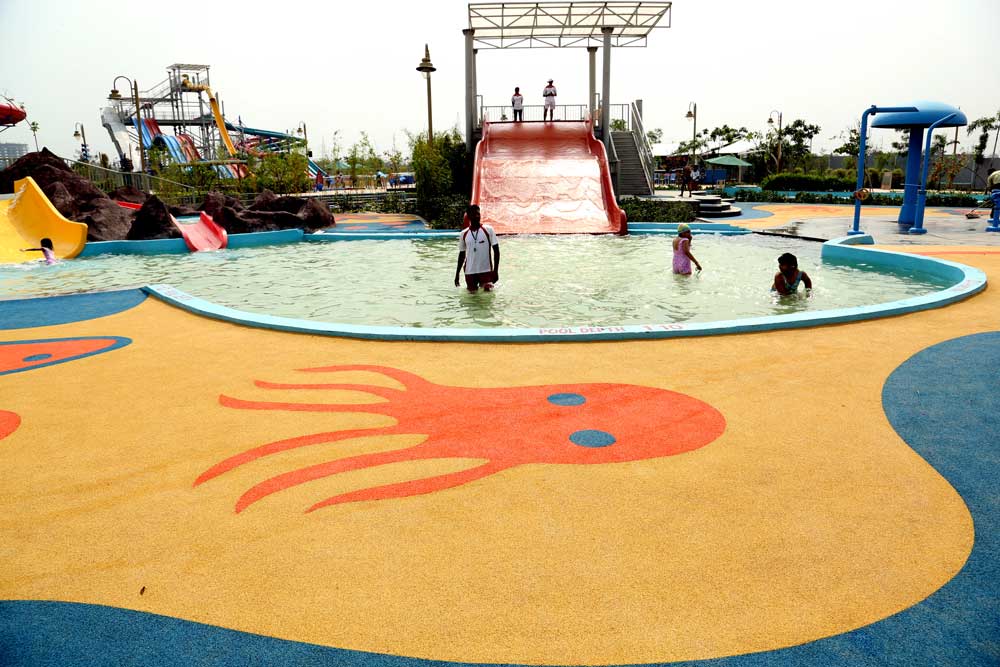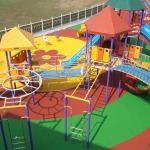Let Your Kid Fall Safely

An example of safe flooring at Worlds Of Wonder, Noida
Childhood is remembered by the scars that games leave behind. Unfortunately, some play accidents, mostly on account of playground falls, lead to hospitalizations or even unwanted dislocations.
The playground equipment like slides, see-saws, multi-activity systems, or even the modern play equipment like scooters and bicycles also contribute to falls and wounds. The scarcity of open parks in cities resulting in crowding of play areas further heightens the risk of playground injuries. All these factors have ushered in a need for safe floors for kids to play on.
How do injuries occur?
Some of the common injuries that occur during play are—fractures, abrasions, lacerations, strains and sprains, and concussions. According to a research conducted by Indian Journal of Public Health, the children between the age group of 11-12 years of age get hurt the most. Amongst all children who suffer from injuries, boys (68 per cent) tend to get hurt more than girls. Falls on the floor is the primary cause of about 80 per cent of injuries amongst children. Collision is found to be the next biggest reason behind injuries. Playground equipment like climbing equipment, swings and slides too contribute to wounds, according to the research.
“Rapidly changing lifestyles, increasing motorization, relative softness of tissue and body parts of children and their psychological characteristics like impulsiveness, curiosity, experimentation, lack of knowledge on judgment of distance and speed, low level of concentration make children vulnerable to injuries,” the research paper states.
How to avoid injuries?
The best way to save children from potential injuries is surveillance on the part of the parents and other caregivers. However, a constant attention and involvement of the elderly can hinder playtime joys and independence of kids. Although not all, but many play-related injuries can be avoided or their intensity mitigated by being mindful of a few factors. Here are a few tips to ensure your child’s safety.
- Insist that the playground flooring is kept clean always. It should be devoid of dirt, stones, wood chips, and metal pieces.
- Make it mandatory for kids to wear protective gear like helmets and pads while cycling and skating.
- Thoroughly check playground equipment as well as skates for wear and tear, regularly.
- Parents should ensure that skates, bicycles, and scooters, etc., are used on appropriate surfaces only.
- The play areas should avoid sharp edges and suitably possess safety rails.
The role of safety flooring
Rubberized flooring that offers adequate shock absorption is the modern way to prevent most of the playground injuries that kids suffer from. Parents must insist that the playground managements implement safety flooring to suit the requirement of play area.
The high energy-level and restlessness of the children—often increasing the possibility to get hurt—should be factored in while choosing the right flooring product. The following pointers will help parents and playground managements to select the right flooring product for the safety of the kids.
- Cushioning: The flooring product you select must be able to absorb impact of fall, eliminating the scope for injuries.
- Hygiene: The floor should be designed to keep dust, dirt, or mud away.
- Water resistance: The playground floor should not absorb and hold water, ensuring that there is no sogginess after clean-ups or during monsoons. This can help avoid slips, skids, and falls associated with wet floors.
- Safe edges: Its edges should be curved to avoid bruises and cuts.

 Next Post
Next Post